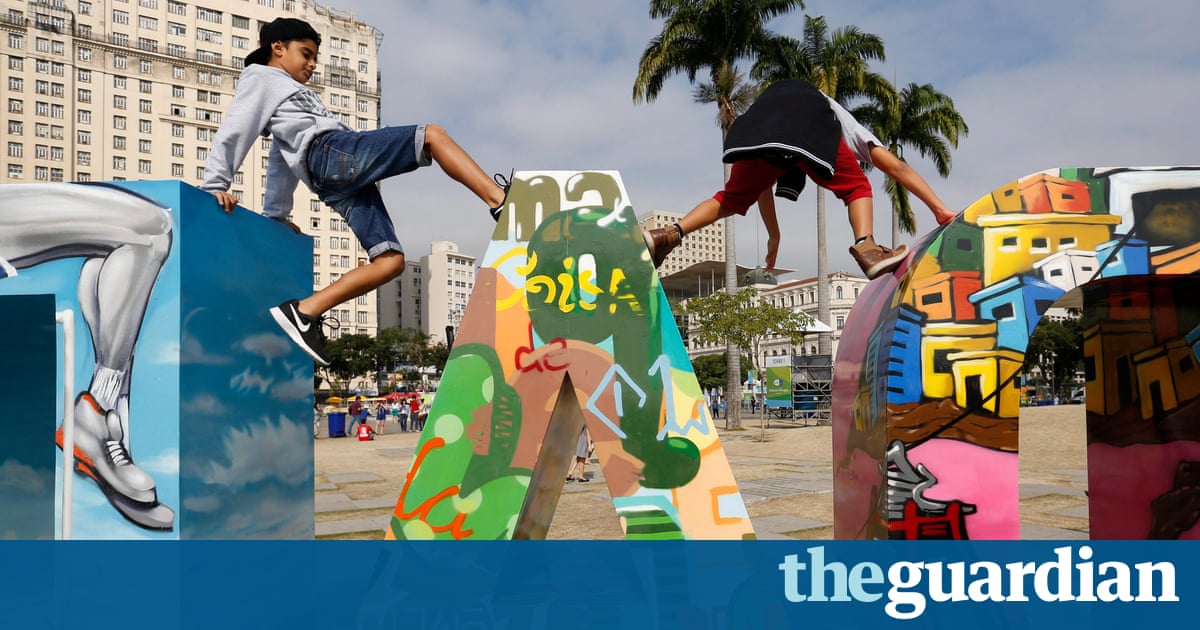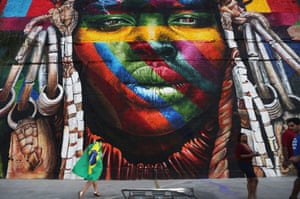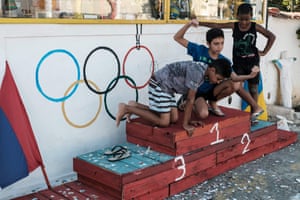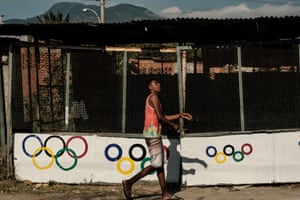After the party: Rio wakes up to an Olympic hangover

When Brazil won the Olympics in 2009, its future looked bright. Seven years on, as the Games come to a close, Rio’s residents are counting the costs.

The Olympic Games arecoming to a close, having demonstrated once again that Rio de Janeiro knows how to organise and promote big events. But after theparty, and the billions spent to show the world that we deserve a place among the great democracies, comes the hangover; thebills begin to arrive, and we have noway to pay. As the festive air and thetourism subside, and with the Paralympics due to start in a matter ofweeks, the old problems remain.
It is now that the residents of Rio deJaneiro begin to wonder: what will the legacy be? As we present ourselves to the world, have we revealed our faults? Or has the power of our cultural creativity come to the fore? Therein lies the contradiction of Rio: the combination of beauty and poverty, hedonism and inequality, a carnival atmosphere and bloody violence.
Hosting the Olympics in Rio was the latest effort an extreme, titanic one to impose the ideal version of Rio over the complexities and contradictions of real Rio. In real Rio, the state government does not have enough money to keep police vehicles on the roads. Police stations are running out of paper. Hospitals are in a precarious situation. State universities are on strike: so far they have not received a penny towards the costs of the current academic year. Thestates 500,000 public servants havereceived their salaries late. Building work has been interrupted. Unemployment is increasing. Social andeconomic inequalities have become more pronounced. Just before the Olympics, Rio state declared a state ofemergency, shifting all these problems on to the shoulders of the federal government which handed it almost abillion dollars to prevent chaos duringthe Olympics. But Rios anxious population is already wondering not so much how the Gameshave gone as what will happen afterwards?
Eduardo Paes, the mayor of Rio de Janeiro, has done everything to try to stop a parliamentary inquiry commission being opened in the municipal chamber to investigate spending on theOlympics. Of the original promises made by Paes for the Games legacy, mainly involving investment in urban mobility and the reduction of pollution, barely half have been met on time. The Games proposed budget of $13bn was exceeded along time ago but a lack oftransparency over the real costs has fuelled suspicions of corruption. And there is more: in the weeks leading up tothe Games, the mayor was still racing to complete the building programme. Other pledged projects will be left in the in-tray of his successor, to be elected in municipal elections in October. The newly laid asphalt on main roads has already started to fail; on 21 April, a section of cycle path on Avenida Niemyer, along Rios waterfront, collapsed weeks after it was opened, killing two people. Public confidence in City Hall, already low, plummeted further. Today, 57% of Rios population do not trust the mayor.

All this is without even factoring in the Zika epidemic, thankfully now less virulent during these cooler winter months. Although not Rio residents most immediate concern, it casts an ever-present shadow, especially given the risk of infected pregnant women passing the virus on to their children, with potentially devastating consequences. Zika started to spread through Brazil in April 2015. From the start of this year up to 28 May, 161,241 probable cases of the virus were registered; of these, 46,027 were in the state of Rio de Janeiro.
For anyone who has lived through Brazils progress over the last two decades, this is a shocking situation. When, on 2 October 2009, Brazil and Rio de Janeiro won the bid to host the 2016 Olympic Games, they did so in the glow of economic success. The enthusiasm of the then president, Luiz Incio Lula da Silva, was contagious: Now is our time! Its here! Of the worlds 10 largest economies, Brazil is the only country that has not hosted the Olympic and Paralympic Games. This will be an unrivalled opportunity for us. It will boost the self-esteem of Brazilians; it will consolidate recent victories; it will stimulate new progress.
In Rio de Janeiro, tens of thousands of people partied on Copacabana beach in the wake of the decision. There seemed plenty of reasons to celebrate. In 2011, Brazil earned its best rating in the Gini inequality index since 1960, the year the index was introduced. Brazil had benefited greatly from a boom in the value of Brazilian exports soy, iron ore, sugar cane and more during this time, and economic growth during the governments of the Workers party president, known as Lula, was accompanied by successful social policies such as the Bolsa Famlia programme, which topped up the income of the poorest families so long as children andadolescents were in school. Other important initiatives included an increase in the minimum wage, and the introduction of policies against racism and the exclusionary effects of poverty.
In 1993, 23% of the Brazilian population lived in extreme poverty, meaning that their income was insufficient forthe minimum number of calories required for healthy survival. By 2009, this figure had fallen to 8.4% still unacceptable, of course, but a dramatic reduction nonetheless. The period from 2003 to 2011 saw 39.6 million Brazilians join the ranks of the so-called new middle class.
But during this time, Brazil also got lucky. In 2006, before the end of Lulas first term in office, the government-owned oil company Petrobras announced the discovery of an oil reserve off the Brazilian coast some 800km long and 200km wide, a substantial chunk of which lies alongside the state of Rio de Janeiro. In the 1990s, Petrobras had been an ailing institution; suddenly, its net profit soared, from $2bn in 2002, to $19bn in 2008. The news of this discovery of one of the worlds biggest reserves of black gold gave Brazilians further optimism: things seemed blessed and glorious. Brazil, and Rio inparticular, had not felt such self-confidence since the late 50s and early 60s. This, of course had been the era ofaccelerated industrialisation, the countrys first football World Cup victory and the construction of Braslia, the new capital and temple of modernist architecture; the age of bossa nova, of Tom Jobim and Joo Gilberto, of Cinema Novo and the great film director Glauber Rocha; of groundbreaking theatre and literature, of socialist dreams. A golden age, violently ruptured by the civil-military coup of 1964, which installed aregime that endured for two decades. Now, in the 2000s, it seemed to many as though that golden age might be reborn.

Rios culture, after all, had never stopped bubbling with variety and vitality. Music continues to be a strong influence, from sophisticated rock shows to funk dance parties in the favelas. More than a million people went to see the Rolling Stones on the beach at Copacabana, and three million take samba to the streets during the four days of the annual carnival.
This organic connection between artand everyday life, the rhythm that pulses in the favelas and appears in more sophisticated visual art, does not occur by accident. It is the product of the most important cultural project ofBrazil, which started in Rio, where itfound fertile ground. Tropiclia began in 1967 with Hlio Oiticica and moved into the music of Caetano Veloso and Gilberto Gil. A 1967 exhibition of Oiticicas work at Rios museum of modern art, entitled Tropiclia, included the sound and movement ofmusicians and dancers from the favela of Mangueira. By then, though, Brazil was a military dictatorship, andthe idea of black and poor people dancing samba was not accepted by thedirectors of the museum. Oiticica resolved the question by moving into the street with the musicians and dancers. This performance made apermanent mark on the Brazilian imagination; it has served as touchstone and inspiration for generations of artists ever since. In Rio, cultural explosion has always been a form of democratic resistance to racism and inequality.
But the economic boom promised by the discovery of oil was not to materialise. Deep-water oil exploration requires heavy investment in technology and equipment investment that led to excessive debt. Then, in late 2014, the price of oil collapsed and, with the dollar rising to 3.50 reais, the cheap money dried up. In desperation, the government of Dilma Rousseff, Lulas successor, artificially controlled the price of oil to combat inflation, caused by weak fiscal policy and the extraordinary costs of subsidised loans to entrepreneurs selected by arbitrary criteria. The operation cost Petrobras $34bn dollars. Approximately the sameamount was lost by the company through the devaluation of the currency.
The damage done by the halting of construction work on new refineries came to almost $46bn. Another $2bn isestimated to have been leached away in corruption involving members of the federal government, state and municipal governors, and almost 200federal members of congress and senators from across almost all parties. This, the greatest scandal in the history of the Brazilian republic, is still being investigated by the Public Prosecutors Office and the federal police. Its repercussions have been unprecedented. Along with the economic crisis and the governments consequent deep unpopularity, the scandal created the conditions for the impeachment of President Rousseff, still ongoing in the federal senate. Today, Petrobrass debt stands at around $100bn. It is now predicted that production in 2020 will be no more than 2.8m barrels per day.
The optimism of the mid-2000s is now a distant memory particularly in the state of Rio de Janeiro, whose economic expectations are so heavily dependent on oil. Rio has ended up avictim of the so-called oil curse, the paradox of those countries which, despite an abundance of oil reserves, end up with less economic stability, less democracy and worse development than countries without oil. In the wake of the fiscal crisis, the economic depression and the collapse of the state came the social effects: the decrease in the already precarious quality of public services dramatically impacting on healthcare, as the Zika epidemic has sohorrifyingly shown mirrored by increases in unemployment and violence. In February this year, unemployment in Rio had reached 8.2%: serious, although not yet a catastrophe. But after the Olympics and Paralympics, the situation is expected to deteriorate.
There are other worrying trends. In2015, there were 1,202 homicides in thecity and 310 deaths resulting from police action. The first three months of 2016 saw a further 328 homicides and 76 deaths resulting from police action. The two state police forces in the city of Rio, the military (responsible for patrols) and the civil (which carries out investigations), are among the most violent in the world; they also cause the most fatalities. Between 2003 and 2015, 11,343 people were killed by police in the state of Rio, mainly by military police. The overwhelming majority ofvictims are young, black and poor. Investigations, when they do take place, are generally inconclusive. In other words, extrajudicial executions are indirectly authorised bygovernments, institutions and the population itself, with people widely believing that the killings will reduce crime. Yet in the first seven months of 2016, 60 police officers were also killed. Despite the declaration in 1988 of Brazils first truly democratic constitution, committed to human rights and the rejection ofracism, Brazils authoritarian tradition is alive and kicking especially as far as concerns worker exploitation, the selective administration of justice, and the lack of public services and support for the most vulnerable slums and theirperipheries.

Rio de Janeiro is a traditionally progressive and iconoclastic city, sceptical of establishment interests and critical of power. Now it is more divided than ever, lacking direction and leadership. The masses find consolation in Pentecostal religious fever, now vying with Catholicism for hegemony. This marvellous picture-postcard city, celebrated in poetry and prose as the paradise of tropical hedonism, of beauty, of sensuality, is beginning to button up itscollar and dress demurely. For many people, Sunday is no longer a day for partying and the beach; its new missionary mood, chaste and abstemious, is taking over squares, Bibles under arms and proselytism in hearts and voices.
Paes greatest error in planning the Olympics was arguably to privilege business and, in doing so, turn a deaf ear to society. Instead of introducing public policies for housing, hospitals, transport and schools in the poorer areas, the mayor has invested in the citys more prosperous western zone, providing further incentives for people to move from the already underpopulated central and northern areas.
Territorial expansion, when there is a lack of resources to provide adequate infrastructure, ends up creating pockets of misery. There have been violent forced displacements, in order to build sports arenas whose maintenance cannot be guaranteed by the public administration and which private interests will have no desire to take on.
Despite all this, the Rio Olympics have been a success. What worries me and many residents is what happensthe day after they finish. In ashort while the Olympic Games will be memory, but they will last for us, who live in Rio, as a major object of political dispute and a challenge for thefuture. Rio de Janeiro is good incredible at the spectacular. Our problem is the everyday.
Translation Lucy Greaves and David Linger. Rio de Janeiro: Extreme City by Luiz Eduardo Soares is published by Penguin.
Read more: https://www.theguardian.com/books/2016/aug/21/rio-2016-olympic-games-brazil-legacy-party